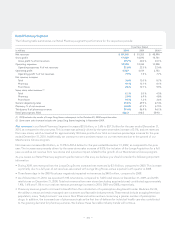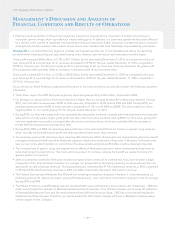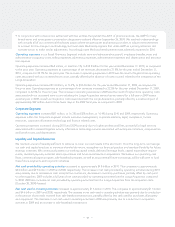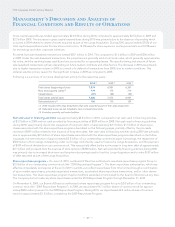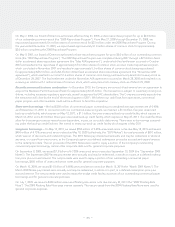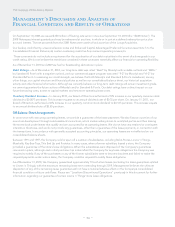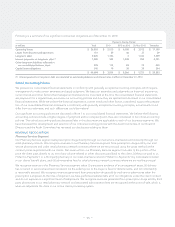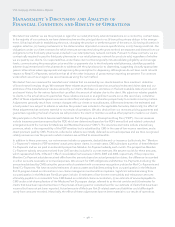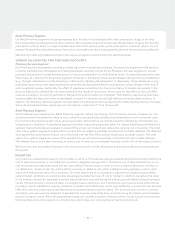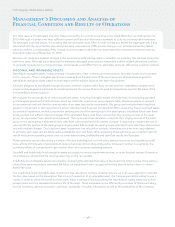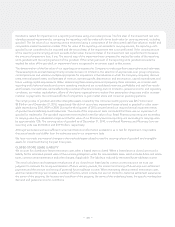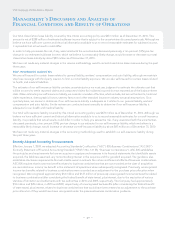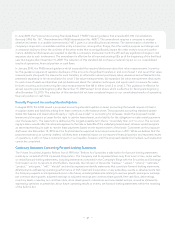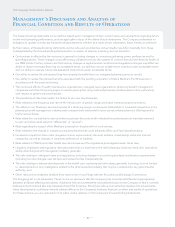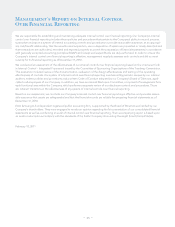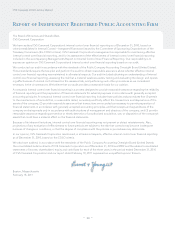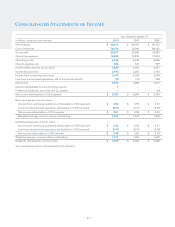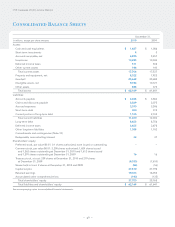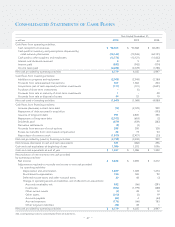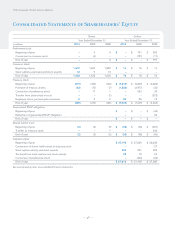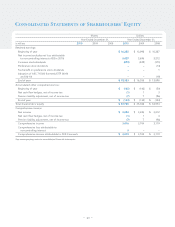CVS 2010 Annual Report Download - page 43
Download and view the complete annual report
Please find page 43 of the 2010 CVS annual report below. You can navigate through the pages in the report by either clicking on the pages listed below, or by using the keyword search tool below to find specific information within the annual report.
Goodwill is tested for impairment on a reporting unit basis using a two-step process. The first step of the impairment test is to
identify potential impairment by comparing the reporting unit’s fair value with its net book value (or carrying amount), including
goodwill. The fair value of our reporting units is estimated using a combination of the discounted cash flow valuation model and
comparable market transaction models. If the fair value of the reporting unit exceeds its carrying amount, the reporting unit’s
goodwill is not considered to be impaired and the second step of the impairment test is not performed. If the carrying amount
of the reporting unit’s carrying amount exceeds its fair value, the second step of the impairment test is performed to measure
the amount of impairment loss, if any. The second step of the impairment test compares the implied fair value of the reporting
unit’s goodwill with the carrying amount of the goodwill. If the carrying amount of the reporting unit’s goodwill exceeds the
implied fair value of the goodwill, an impairment loss is recognized in an amount equal to that excess.
The determination of the fair value of our reporting units requires the Company to make significant assumptions and estimates.
These assumptions and estimates primarily include, but are not limited to, the selection of appropriate peer group companies;
control premiums and valuation multiples appropriate for acquisitions in the industries in which the Company competes; discount
rates, terminal growth rates; and forecasts of revenue, operating profit, depreciation and amortization, capital expenditures and
future working capital requirements. When determining these assumptions and preparing these estimates, we consider each
reporting unit’s historical results and current operating trends and our consolidated revenues, profitability and cash flow results
and forecasts. Our estimates can be affected by a number of factors including, but not limited to, general economic and regulatory
conditions, our market capitalization, efforts of third party organizations to reduce their prescription drug costs and/or increase
member co-payments, the continued efforts of competitors to gain market share and consumer spending patterns.
The carrying value of goodwill and other intangible assets covered by this critical accounting policy was $25.7 billion and
$9.8 billion as of December 31, 2010, respectively. We did not record any impairment losses related to goodwill or other intan-
gible assets during 2010, 2009 or 2008. During the third quarter of 2010, we performed our required annual impairment tests
of goodwill and indefinitely-lived trademarks. The results of the impairment tests concluded that there was no impairment of
goodwill or trademarks. The goodwill impairment test resulted in the fair value of our Retail Pharmacy reporting unit exceeding
its carrying value by a substantial margin and the fair value of our Pharmacy Services reporting unit exceeding its carrying value
by approximately 12%. The carrying value of goodwill as of December 31, 2010, in our Retail Pharmacy and Pharmacy Services
reporting units was $6.8 billion and $18.9 billion, respectively.
Although we believe we have sufficient current and historical information available to us to test for impairment, it is possible
that actual results could differ from the estimates used in our impairment tests.
We have not made any material changes in the methodologies utilized to test the carrying values of goodwill and intangible
assets for impairment during the past three years.
CLOSED STORE LEASE LIABILITY
We account for closed store lease termination costs when a leased store is closed. When a leased store is closed, we record a
liability for the estimated present value of the remaining obligation under the noncancelable lease, which includes future real estate
taxes, common area maintenance and other charges, if applicable. The liability is reduced by estimated future sublease income.
The initial calculation and subsequent evaluations of our closed store lease liability contain uncertainty since we must use
judgment to estimate the timing and duration of future vacancy periods, the amount and timing of future lump sum settlement
payments and the amount and timing of potential future sublease income. When estimating these potential termination costs
and their related timing, we consider a number of factors, which include, but are not limited to, historical settlement experience,
the owner of the property, the location and condition of the property, the terms of the underlying lease, the specific marketplace
demand and general economic conditions.
– 39 –


